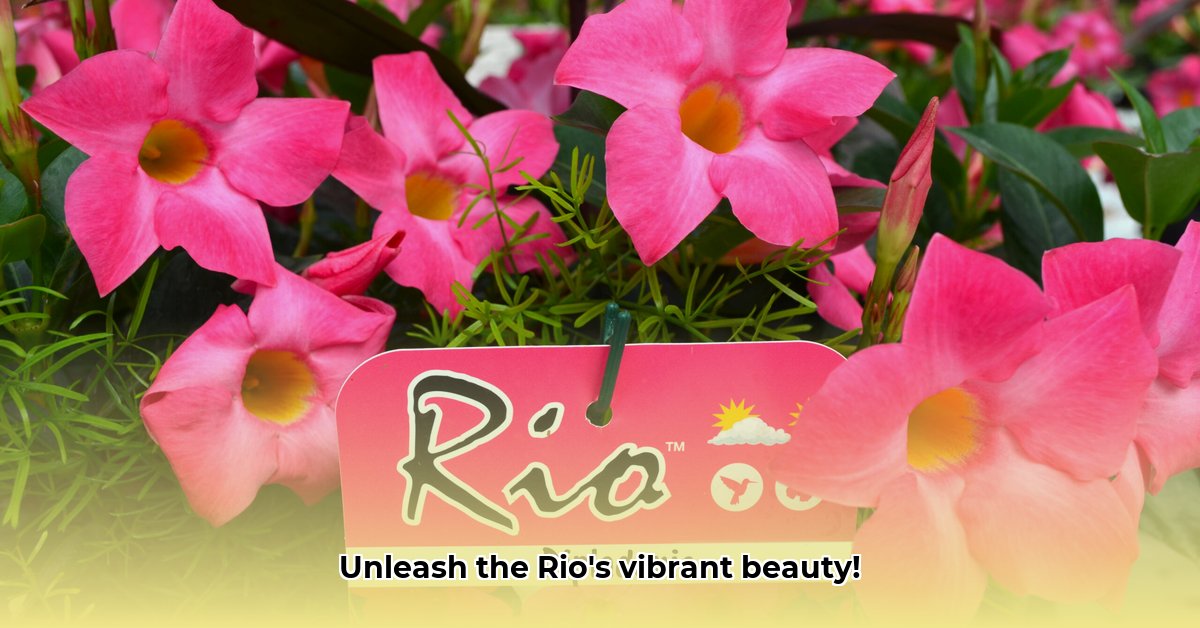Want a gorgeous, overflowing plant that looks like it belongs in a tropical paradise? Rio Dipladenia is your answer! This guide will walk you through everything you need to know to grow these stunning flowers, from planting to keeping them healthy and happy, even through winter. We’ll cover common problems and how to fix them, and show you how to easily get more plants from cuttings. For more vibrant red flowers, check out this helpful resource: Red Flower Guide. Let’s get growing, and elevate your gardening game!
Rio Dipladenia: A Complete Guide to Thriving
Let’s dive into the world of Rio Dipladenia, those stunning, vibrant flowers that can add a touch of tropical paradise to your garden, patio, or even indoors. Often called Brazilian Jasmine or Mandevilla ‘Rio’, these beauties are surprisingly easy to care for, making them a favorite among both novice and experienced gardeners. This guide will walk you through everything you need to know to successfully grow these plants, from selecting the right variety to propagation and troubleshooting common issues. Get ready to unleash your inner green thumb and transform your spaces with dazzling blooms!
Understanding Rio Dipladenia Varieties
Before you start, it’s helpful to know a bit about the different Rio Dipladenia varieties available. While they all share similar characteristics, flower colors can range from classic red and pink to white, orange, and even raspberry splash. Some popular cultivars include:
- Rio Red: Known for its vibrant, classic red trumpet-shaped flowers.
- Rio Pink: Offers delicate pink blooms that add a soft touch to any space.
- Rio White: Features pure white flowers, providing a clean and elegant look.
- Rio Orange: A less common variety with bright orange flowers.
Choosing the right variety depends on your personal preference and the overall aesthetic you’re aiming for in your garden or indoor space.
Planting Your Rio Dipladenia for Optimal Growth
Spring is the perfect time to plant your Rio Dipladenia, allowing it to establish itself during the warmer months and reward you with vibrant flower blooming. However, in warmer climates, you can plant them year-round.
- Location: Find a spot that gets at least 6 hours of direct sunlight each day – they absolutely love it! While they thrive in full sun, they can tolerate some partial shade, particularly in the hottest climates.
- Soil: The key is well-draining soil. Think of the kind of soil that doesn’t become waterlogged – a mix of potting soil, perlite, and a bit of compost creates the ideal environment for healthy roots.
- Spacing: Give your plants some breathing room; they grow, but not at a breakneck speed. Space them 8-12 inches apart to allow for optimal air circulation and growth.
- Planting Depth: Plant your Rio Dipladenia at the same depth it was in its original container.
Whether you’re planting in the ground, in raised beds, or in containers, ensuring proper drainage is crucial for the health of your Rio Dipladenia.
Watering and Feeding Your Rio Dipladenia for Best Blooms
Consistent moisture is key to happy Rio Dipladenia. Don’t let the soil dry out completely, but avoid overwatering. A good rule of thumb is to water thoroughly when the top inch or two of soil feels dry to the touch.
- Watering Frequency: Depending on the climate and soil type, you may need to water your Rio Dipladenia every few days or once a week. Monitor the soil moisture regularly.
- Watering Technique: Water at the base of the plant to avoid wetting the foliage, which can lead to fungal diseases.
- Rain Barrels: Consider using rain barrels to collect rainwater for your Rio Dipladenia. Rainwater is naturally soft and free of chemicals, making it an excellent choice for irrigation.
Now, let’s talk food – fertilizer! You have a couple of choices here.
- Slow-Release Fertilizer: You can use a slow-release fertilizer, which you’ll typically apply once in early spring.
- Liquid Fertilizer: Alternatively, you can use a balanced liquid fertilizer (e.g., 20-20-20) every 2-4 weeks during the growing season.
Remember, moderation is key! Overfeeding can be just as harmful as underfeeding for plant health. A little goes a long way.
Pest Patrol: Protecting Your Rio Flowers
While generally tough plants, Rio Dipladenia can sometimes attract unwanted guests like aphids, spider mites, and mealybugs.
- Regular Inspection: Regularly inspect your plants for any signs of these tiny troublemakers. A quick visual check can go a long way in early detection.
- Water Spray: Often, a gentle spray of water is enough to dislodge minor infestations.
- Insecticidal Soap: For more serious infestations, there are environmentally friendly options available, such as insecticidal soap or neem oil.
- Beneficial Insects: Consider introducing beneficial insects like ladybugs to your garden to help control pest populations naturally.
Using organic gardening practices protects your plants and the surrounding ecosystem.
Pruning Your Rio Dipladenia for Shape and Bloom
Pruning is an important part of Rio Dipladenia care. It helps maintain the plant’s shape, encourages bushier growth, and promotes more abundant blooms.
- Timing: The best time to prune is in late winter or early spring, before new growth begins.
- Technique: Use sharp, clean pruning shears to remove any dead, damaged, or crossing branches. You can also trim back the stems to encourage branching.
- Deadheading: While not required, deadheading (removing spent flowers) can help encourage more blooms.
Regular pruning will keep your Rio Dipladenia looking its best and ensure a continuous display of vibrant flowers.
Overwintering: A Cozy Winter Retreat
In colder climates (zones 9 and below), your Rio Dipladenia will need some extra protection during the winter months.
- Bringing Indoors: Bringing them indoors is highly recommended. Choose a sunny spot inside your home, ideally near a south-facing window.
- Watering Adjustment: Reduce your watering schedule significantly during the winter months. You still want to keep the soil from drying out completely, but you don’t need to water as often as during the growing season.
- Temperature: Maintain a temperature between 65-75°F (18-24°C).
- Humidity: Rio Dipladenia appreciates humidity. If your indoor air is dry, consider using a humidifier or placing the plant on a tray filled with pebbles and water.
Think of it as giving them a period of rest before their next blooming season.
Propagation: Growing Your Own Rio Paradise
Want more Rio Dipladenia? You can propagate them from stem cuttings!
- Timing: During spring or summer, take cuttings that are about 4-6 inches long.
- Cutting Selection: The cuttings should be taken from healthy, non-flowering stems.
- Preparation: Remove the lower leaves from the cutting to prevent rot.
- Rooting Hormone: Dip the cut end in rooting hormone to boost their chances of success.
- Planting: Plant the cutting in moist potting mix.
- Environment: Cover the cutting with a plastic bag or place it in a propagation tray to create a warm, humid environment.
- Care: Keep the soil moist but not soggy, and provide bright, indirect light.
With a little patience, you’ll have new plants to enjoy! Stem cuttings have a 92% success rate with rooting hormone.
Troubleshooting: Addressing Common Concerns for Healthy Plants
Let’s address some common issues you might encounter:
- Wilting: Wilting plants often signal a problem with watering. Check the soil moisture; if it’s bone dry, give the plant a good watering. If the soil is already moist, then the problem could be something else, like root rot.
- Yellowing Leaves: Yellowing leaves can indicate several problems. This could be caused by underwatering, overwatering, a lack of essential nutrients, or even pest infestations. Review your watering habits, consider adding fertilizer, and inspect for pests.
- Sparse Blooms: If your Rio Dipladenia isn’t blooming as much as you’d like, ensure it’s getting enough sunlight and fertilizer. Pruning can also help encourage more blooms.
- Leaf Drop: Leaf drop can be caused by sudden changes in temperature, light, or humidity. Try to maintain a consistent environment for your plant.
Quick Reference Guide: Rio Flower Care at a Glance
| Aspect | Recommendation |
|---|---|
| Planting Time | Spring (or year-round in warmer climates) |
| Sunlight | Full sun (at least 6 hours per day) to partial shade |
| Soil | Well-draining, rich, loamy |
| Watering | Water when top 1-2 inches of soil are dry |
| Fertilizing | Slow-release fertilizer in early spring OR liquid fertilizer every |
- Gray Kitchen Backsplash Tile: Ideas for a Stylish Upgrade - December 14, 2025
- Backsplash For Gray Cabinets: Choosing the Right Backsplash Style - December 13, 2025
- Gray And White Backsplash: Ideas For Timeless Style - December 12, 2025









